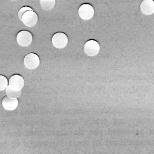Analyzing images for data statistics is usually done after applying binary operations for segmenting the image. Regions of interests are the objects of study and these are segmented from the image background to make some measurements of the objects. Doing these for an image contaning a large number of objects under study is quite a tedious task. In this regard, it is important to provide image processing techniques for segmenting the objects not just from the background, but also in isolating them from other objects in the image. Thresholding and morphological operations can be applied. Using this technique results to better measurement estimates because of the number of samples that can be processed. Statistics can be generated to describe the measurements in processing more objects in a single image, and even for multiple images.
One important application of this technique is the cell count and measurement of the area of a cell. Abnormally sized cells can be detected, which can provide some diagnosis for a certain disease.
In this activity, cells are simulated as circular papers (papers from punched holes). The area of the circles are estimated. As an analog, a large image of the circular papers represent a whole blood sample. Looking through the microscope, this whole blood sample is actually subdivided into smaller views, so the large image of the circular papers were subdivided into smaller images (which may be overlapping). Sampling a single circle twice would provide a better statistics of the data because more acceptable data are measured. This would also help in easily detecting outliers in the area count because, obviously, there should be more circles in the images.
First, thresholding and morphological operations are applied to enhance the images (using Scilab functions). After obtaining a binarized image (threholding), the subimages are cleaned by removing small white patches and incomplete circles. This was done by applying the opening operation. Opening operations is basically an application of dilation after the erosion morphological operation (from the previous activity). Using a circular structuring element with a radius slightly smaller than the circles, small objects and the overlapping regions circles can be removed. Initial erosion using the structuring element makes the circles (where the structuring element can fit) smaller, removing the overlap against another circle and also removing in the image all objects in which the structuring element cannot fit. Afterwards, dilation using the same structuring element would regenerate the form of the circles, which would produce an image ideal for data processing. The circular shape of the structuring element was chosen to provide this same form of circle. Afterwards, labeling was made so as to count the areas for each (ideally) isolated circle. The statistics for the area count were obtained.
Original image








 Mean: 559 (558.71233 )
Mean: 559 (558.71233 )Standard Deviation: 219 (218.94237)
The large standard deviation arises from the outliers. These are caused by the blobs from the joined circles which produced very high area estimates. Analyzing the histogram above, these outliers can be omitted from the data set such that the area estimate can be obtained from the proper statistical distribution.

Histogram without the outliers
Mean: 491 (491.04615)
Standard Deviation: 54 (54.256172)
Removing the outliers provides a better estimate of the area. This is also evident for the standard deviation. It is significantly smaller without the outliers indicating that the all the measured data are very consistent. It also suggests that the area estimate is accurate because it is the consistently measured at the approximately the same value.
For this activity, I would like to give myself a grade of 10 since all of the requirements are presented and the results are very satisfactory.
I would like to thank Dr. Maricor Soriano for discussions regarding this activity.
For this activity, I would like to give myself a grade of 10 since all of the requirements are presented and the results are very satisfactory.
I would like to thank Dr. Maricor Soriano for discussions regarding this activity.











No comments:
Post a Comment